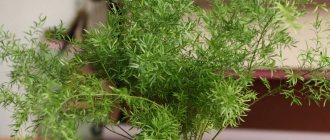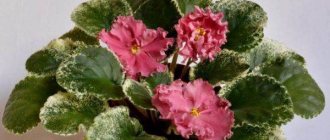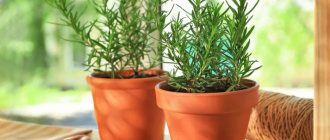In our apartments you can often find a representative of the subtropical flora - Meyer's asparagus. It is successfully grown not only indoors, but also in garden plots, balconies and loggias in the warm season. Temperatures of +12°C are well tolerated by the plant, but when it drops below +10°C, the flower must be moved indoors.
Description and photo
The plant is a small shrub that branches as soon as it emerges from the root system. It grows 3-4 meters wide and reaches half a meter in height .
The central stems are straight, but bend under the weight. Numerous shoots emerge from them, covered with small and thin cladodes “needles” that look like plant leaves. Real leaves have the appearance of scales that are virtually invisible.
general information
The genus of asparagus is distributed literally in all climatic zones and on all continents. Although it is most often found in Asia, Europe and Africa. In some latitudes it is even grown on special plantations, but this only applies to edible varieties.
Asparagus is a perennial, but its form can be a shrub, vine or herbaceous plant. Instead of leaves on thin stems, equally thin and flexible shoots diverge. They resemble elongated needles and are called cladodes. In all external parameters, asparagus resembles a lily, but with a wide branched rhizome.
Asparagus blooms with pale small flowers, and then scarlet berries form. Moreover, the flowers are unisexual and bisexual, even within the same bush. But keep in mind that it is almost impossible to achieve flowering on the windowsill at home.
Photo: fermerss.ru
How is it different from other types?
The main difference from other species is that the shoots bend under their own weight and fall down, and usually reach about half a meter in length. The needles are arranged quite tightly and resemble a Christmas tree in appearance. This type of asparagus is especially loved by designers.
Read on our website also about other types of asparagus: pinnate, crescent, Sprenger.
Landing
- Choosing a pot. Asparagus produces many shoots, and the root system grows in breadth. Therefore, you should give preference to wide and deep pots.
- What should the soil be like? The plant needs loose soil with an alkaline reaction. An excellent option would be the following proportion 2: 1: 1: 1, consisting of turf soil, humus, leaf and river sand, preferably coarse-grained.
- How to plant? There are several ways to plant a plant: buy a ready-made cutting or plant a flower from seeds.
Home care
- Temperature. The flower is accustomed to a relatively cool temperature of 20 to 22 degrees Celsius. If it is impossible to achieve such a temperature regime at home, then in the summer we take the plant to the balcony. In winter, the temperature is from 12 to 15 degrees, but it should not fall below 10.
- Lighting. If the plant is placed in a room, preference should be given to windows facing west or south. The flower prefers bright illumination, but it should be diffused. Do not place the plant in direct sunlight, which can harm the plant.
- Watering. During the summer season, which begins in spring and ends in autumn, it is necessary to keep the soil moist, but do not overwater the plant, otherwise it will rot. You must use water that does not contain chlorine. In winter, watering is reduced, and the top layers of the soil may even dry out.
- Feeding. Fertilizers should be used during active plant growth; mineral and organic additives are suitable. Microelements can be administered once every two weeks.
- Trimming. There is no need to prune the plant regularly. Only dried or dead shoots are removed. Trimming the plant will not cause more growth, but will most likely stop it.
- Transfer. The plant needs to be replanted in the spring. If the flower no longer fits in the old pot, then it is necessary to give preference to a vessel with a larger diameter and depth. When replanting, you cannot remove all the nodules, which are a source of nutrients for the plant. But to rejuvenate the root system, you can partially remove them.
- Care during the flowering period. If you do not need seeds, then after flowering the ovaries should be removed immediately to prevent the appearance of seeds. This will allow the plant to continue to grow without spending additional energy on maintaining the fruit.
- What to do if it doesn't bloom? Usually the cause of non-flowering is lack of proper care. It is necessary to identify the problem and fix it, for example, adjust the irrigation system or change the location to a sunnier one.
Reference! As much as you want to see buds on your favorite plant, you need to understand that asparagus flowering at home is a rare occurrence.
Uses of asparagus
Asparagus is used in various areas of life:
- Floristry . The airy carved greenery has made the flower popular not only among flower growers, but also florists, whose compositions often include branches of the plant: asparagus tripherna is often used to decorate bouquets.
- Cooking . Three types of asparagus (white, green and purple) are used as food and are rich in micronutrients and vitamins. The most common and easily accessible is green asparagus, without which some culinary recipes cannot be implemented.
- Ethnoscience . The beneficial properties of this flower are not limited to purifying the air and enriching it with phytoncides. The perennial has medicinal qualities that can fight gout, liver diseases and other ailments, having sedative, analgesic, vasodilating, diuretic, and blood purifying effects.
Advice! Do not forget that no matter how undeniable the benefits are, there are also harms from using the plant. In some cases, asparagus can act as an allergen.
Thus, due to the unpretentiousness of the perennial and its high decorative value, asparagus is popular among lovers of tropical flora.
Spectacular hanging plants such as robot asparagus or Abu Dhabi asparagus with graceful cascading stems will add coziness to any room, adding bright colors of greenery to the interior.
Features of reproduction
You can get a new plant in two ways: dividing the bush and growing from seeds.
Seeds should be planted in the second half of February or the first half of March.
Seeds are scattered into the prepared moistened soil, and cellophane is stretched over the container, creating a portable greenhouse. Seeds germinate in about three to four weeks .
Dividing the bush can be done throughout the year, but it is still better to do this before the start of the growing season.
Sowing
The distance between seeds should be at least 3 centimeters. Lightly press them into the soil, and then cover them with a thin layer of the same soil mixture and moisten them. Cover the container or container with the seeds with glass or transparent film and place in a warm place with good lighting. This mini-greenhouse needs to be ventilated every day. At least twice a day, the soil should have access to fresh air for five, preferably ten minutes. Until the first shoots appear, moisten the soil systematically and do not allow its top layer to dry out. If the container is small in size, then the best place for it would be a window sill.
How long does it take for seeds to germinate? Usually amicably, if not simultaneously. You will see the first shoots in one to two weeks. The timing of their appearance depends on the condition of the seeds, air and soil temperatures and, of course, on the quality of the soil. To speed up the germination of seeds, they can be soaked in water before planting and left to swell for a day.
When sprouts appear, remove the film or glass from the greenhouse. From this time on, you can reduce watering, but do not allow the soil to completely dry out the top layer.
Diseases and pests
The main pest of the plant is the spider mite, which settles between the needles of the leaves. At the same time, the plant does not tolerate chemicals that are commonly used to treat flowers in the presence of pests. In this case, we rinse the plant several times under warm water until all the pests are washed away. And then it is treated with diluted Actellik.
Attention! Dull leaves, lack of color, and falling needles are a clear consequence of improper plant care.
To identify the problem, you need to review the rules of care.
Possible problems
Possible problems when growing asparagus are most often the consequences of improper care:
- The absence of flowering or yellowing of the side shoots indicates dry air.
- The pale color of the crown indicates an excess of light at the location of the asparagus.
- Yellowing and falling of the leaves - cladodes - may be due to a lack of calcium due to watering the plant with too soft water. The plant, accustomed to saline soils, prefers hard, settled water.
How to protect an Ethiopian guest?
The main prevention of diseases and problems arising with the plant is compliance with the rules of care and temperature conditions. It is also worth maintaining a balance when watering and applying mineral fertilizers. Regularly inspect the plant for pests, parasites and fungal diseases , which must be immediately treated and prevented at the stage of their appearance.
Regular watering, sufficient lighting, proper feeding and timely replanting, coupled with periodic inspection of the plant for pests, will provide your pet with everything necessary and Meyer’s asparagus will always please the eye with a healthy and beautiful appearance.
Why do indoor asparagus leaves turn yellow, dry out and fall off, what to do in such situations?
The answer to the question of why the thin leaves of exquisite asparagus turn yellow may be excessive exposure to bright sunlight, as a result of which the plant develops a burn and characteristic yellowness.
Dry soil is another reason why the attractive indoor asparagus flower turns yellow. The frequency and intensity of water procedures should be reconsidered. However, you shouldn’t overdo it here either, since excess moisture contributes to rotting of the root system, which leads to wilting and death of the flower.
Therefore, it is important to find the “golden mean” in the watering regime in order to achieve a healthy green shine of stems and leaves.
Beginners often wonder why homemade asparagus dries out, when the answer may be quite simple - lack of lighting. In such cases, the course of treatment is elementary and involves changing the location of the flower pot with greater intensity of sunlight. As for dried branches, they should be cut off, since they cannot be “restored” and only spoil the appearance of the indoor “handsome”. By following these recommendations, even a beginner can ensure that the flower will soon delight you with new succulent shoots.
The reason why the bright green asparagus leaves turn yellow and fall off may also be due to harmful insects, which, by parasitizing, disrupt the normal life cycles of the plant. Among the pests of this plant, the most frequent “guests” are:
Aphid.
Spider mite.
Shield.
Aphids, which appear on an ornamental bush after “walks” in the garden in the summer, not only deplete it, but also cause the leaves to dry, wither and fall off. The only way to “expel” these pests is to treat them with special insecticides and provide comfortable growing conditions for the bush to renew lost “strength”.
Among these modern drugs, the most effective will be:
- "Agravertine".
- "Confidor".
- "Etisso."
- "Talstar."
- "Bazudin."
In a situation where asparagus is left for a long time in a dry, poorly ventilated room, there is a high probability of spider mites appearing. These parasites, feeding on the juice of the stems, deplete the plant, as a result of which the leaves of indoor asparagus wither and turn yellow. The question of what to do in such situations and how to deal with uninvited “guests” is one of the most frequently asked by beginning gardeners.
As a treatment, it is worth spraying the crowns of the bush with a concentrated solution of Actellica, and subsequently, for prevention, carry out irrigating procedures with warm water, covering the soil.
Parasitism by scale insects may also explain why asparagus leaves suddenly turn yellow. The list of what to do with this problem will be similar to the actions when fighting spider mites. However, you should first clear the stems of insects, which resemble brown convex plaques. An alternative folk method of getting rid of such pests can be a soap solution, but the difficulty will only lie in its subsequent washing off by repeated spraying with clean water.
Experienced flower growers, having analyzed the habitat and basic care conditions, can immediately determine the reasons for the deterioration in the “well-being” of the home “lace” bush. And this is already a large part of the path to full recovery and its active growth.











